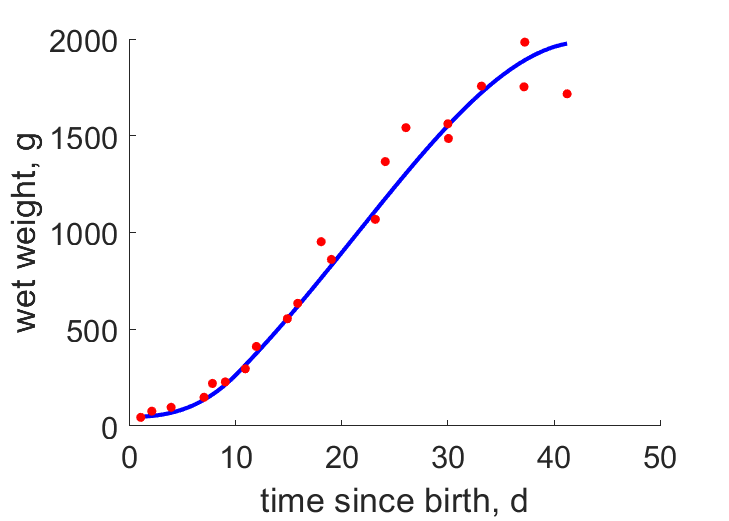Predictions & Data for this entry
| Model: std | climate: A, B, C, D | migrate: Ml | phylum: |
| COMPLETE = 2.5 | ecozone: TH, TP, TA | food: biCvf | class: |
| MRE = 0.018 | habitat: 0xMc, 0xFm | gender: Dg | order: |
| SMSE = 0.003 | embryo: Tnpfm, Tncfm | reprod: O | family: |
Zero-variate data
| Data | Observed | Predicted | (RE) | Unit | Description | Reference |
|---|---|---|---|---|---|---|
| ab | 30 | 30.12 | (0.003989) | d | age at birth | AnAge |
| tx | 41 | 41.04 | (0.0008745) | d | time since birth at fledging | PlatKoff1995 |
| tp | 123 | 122.6 | (0.003037) | d | time since birth at puberty | guess |
| tR | 1460 | 1460 | ( 0) | d | time since birth at 1st brood | AnAge |
| am | 9928 | 9984 | (0.005644) | d | life span | AnAge |
| Wwb | 48.5 | 48.32 | (0.003671) | g | wet weight at birth | AnAge |
| Wwi | 2300 | 2299 | (0.0005487) | g | ultimate wet weight | PlatKoff1995 |
| Ri | 0.01096 | 0.01094 | (0.002121) | #/d | maximum reprod rate | AnAge |
Uni- and bivariate data
| Data | Figure | Independent variable | Dependent variable | (RE) | Reference |
|---|---|---|---|---|---|
| tW |  | time since birth | wet weight | (0.08033) | PlatKoff1995 |
Pseudo-data at Tref = 20°C
| Data | Generalised animal | Phalacrocorax carbo | Unit | Description |
|---|---|---|---|---|
| v | 0.02 | 0.0256 | cm/d | energy conductance |
| p_M | 18 | 1078 | J/d.cm^3 | vol-spec som maint |
| k_J | 0.002 | 0.04429 | 1/d | maturity maint rate coefficient |
| k | 0.3 | 0.3 | - | maintenance ratio |
| kap | 0.8 | 0.9794 | - | allocation fraction to soma |
| kap_G | 0.8 | 0.802 | - | growth efficiency |
| kap_R | 0.95 | 0.95 | - | reproduction efficiency |
Discussion
- Feeding is reduced towards just after hatch
- Body temperature is guessed
- mod_1: v is reduced
- mod_2: Pseudo-data point k is used, rather than k_J; Data set tp and parameter t_R are added, the latter replacing clutch interval t_N. Postnatal T is based on PrinPres1991, see get_T_Aves. See further the revision page, theme puberty
Bibliography